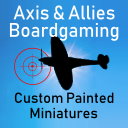963e05bb-6f42-4823-85a8-8779a5c87bfd-image.png a87ba10a-ce07-41c2-8d5e-24ab2b2c4580-image.png
Imperial Scramble: A Game of 19th Century War and Imperialism
-
Finally, I can post some pictures! Here are some good ones from the most recent play test.
Here is the starting situation.


Here is the board at the end.



-
Thanks for the pictures. Are the sculpts from the Viktory II game?
-
I bought the pieces on Amazon from a supplier called Morrison Games. Here is the link. After reading your post though, I checked out pictures of Victory II and found that they look identical. I guess that Victory II buys its pieces from Morrison Games? I don’t know…
Also, I just want to let everyone know that I am planning an online play test. So, if you are interested, please let me know.
-
Don’t forget Suez canal opened 1869.
You need to issue shares in the company for player investment.
-
I love Victoria Era Europe, looks great.
-
Another game that might serve as a useful source of inspiration is War: Age of Imperialism, by Eagle Games.
-
Thanks for sharing nice information about risk game, i really love it Risk game. Risk is one of the world’s most popular board games which are available online.
“Life is a game but Risk is a serious”
Also you should follow below link if you want to play it
-
@CWO:
Another game that might serve as a useful source of inspiration is War: Age of Imperialism, by Eagle Games.
The Secret Society of Parts Hounds laugh as they deviously strike again! +1 my friend. Never played this one. Though I do own it because I got it for FREE, and had cool parts.
-
This game to me is not my personal cup of tea. However I really support your endeavor. There are some Youtube videos made by the guy who designed Victory II. He started out making the game himself and he explains how he got it to market. You should look this up.
I wish you luck and hope it all works out.
-
Never played this one. Though I do own it because I got it for FREE, and had cool parts.
Same for me (except for the part about getting it for free). I particularly like the standard infantryman, with the raised rifle and pith helmet, whose design fits nicely for possible use as a WWII British or French colonial infantry unit. The size is just right, the detailing is pretty good and there’s a wide range of colours available. The single drawback is the rectangular base, since it contrasts so much with the round bases of the OOB and HBG units.







